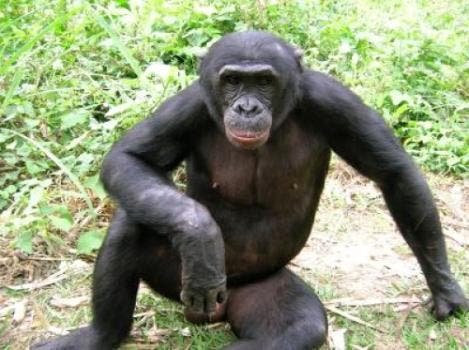
The Bonobo, or Pygmy Chimpanzee as it was once called, is one of our closest relatives, yet one of the most poorly studied. This fascinating ape displays unique social order and other highly interesting traits, and unfortunately like all great apes it is also endangered. Very little is known, however, about how many specimens are there in the wild or how exactly threatened the bonobos currently are. In the most extensive study of its kind to date, a team of international scientists modeled bonobo habitat based on scarce and ready-available data in order to find what the true scale of these threats is. The results reveal that the bonobos are quickly running out of space and their habitat is far narrower and spaced apart than previously believed.
“This assessment is a major step towards addressing the substantial information gap regarding the conservation status of bonobos across their entire range,” said lead author Dr. Jena R. Hickey of Cornell University and the University of Georgia. “The results of the study demonstrate that human activities reduce the amount of effective bonobo habitat and will help us identify where to propose future protected areas for this great ape.”
“For bonobos to survive over the next 100 years or longer, it is extremely important that we understand the extent of their range, their distribution, and drivers of that distribution so that conservation actions can be targeted in the most effective way and achieve the desired results,” said Ashley Vosper of the Wildlife Conservation Society. “Bonobos are probably the least understood great ape in Africa, so this paper is pivotal in increasing our knowledge and understanding of this beautiful and charismatic animal.”
A great ape society based on love
One of mankind’s closest living relatives, the bonobos share more than 98% of our DNA or nearly as much as chimpanzees. Actually, they closely resemble chimpanzees with the key physiological distinction that they’re smaller hence the pygmy nickname. The similarities more or less end here though; while chimpanzees are loud, competitive and aggressive, the bonobo apes live in a peaceful, matriarchal and egalitarian society. In times of seldom conflict and tension or when promoting bonding or sharing alike, the bonobos choose to address all of these through sexual behavior. Like in human society, for Bonobos sex transcends reproduction and is seen as a means of expression and passionate caring. With this in mind, bonobos serve as a powerful symbol of peace and cooperation. Unfortunately, these great apes are listed as highly endangered, according to the IUCN Red List.
Bonobos, like their chimpanzee cousins, live in “fission-fusion” societies and therefore tend to vary in party size. Communities of up to 100 bonobos will usually split into small groups when searching for food during the day and come back together to sleep at night. Also, bonobos are considered the most vocal of great apes as they frequently use complex vocal communication accompanied by hand gestures. Animal behaviorists believe these vocal fixtures play a pivotal role in bonobo society, helping them communicate with one another where favorite food sources are located, as well as the quality and preference of these foods function of vocal sequences. The voice itself, or better said howl since it’s not articulated, is quite pleasant to the human ear being melodic and high pitched, in contrast to the deeper and more guttural vocalizations of a chimpanzee.

Bonobos live only within the lowland forests of the Democratic Republic of Congo; a country beset by war, filled with corruption and where sadly poachers have their way. Previously, it was thought they inhabit approximately 500,000 square kilometers (193,000 square miles) of tropical forest south of the Congo River and north of the Kasai River, where the average rainfall is between 63 and 80 inches per year. This latest assessment shows, however, that bonobo range has dwindled greatly.
It’s impossible for the researchers to check every bonobo nest in the country, but what they attempted to do is the next best thing: create a model. Based on data of bonobo nest locations collected by numerous organizations between the years 2003-2010, the researchers identified 2364 “nest blocks,” with a block defined as a 1-hectare area occupied by at least one bonobo nest. Where nests weren’t identified in a region before, these interpolated based on previous data. The group then tested a number of factors that addressed both ecological conditions (describing forests, soils, climate, and hydrology) and human impacts (distance from roads, agriculture, forest loss, and density of “forest edge”) and produced a spatial model that identified and mapped the most important environmental factors contributing to bonobo occurrence.
Just a quarter of bonobo range is suitable
Results showed that the most obvious marker that skewed bonobo presence was human intervention through agriculture. The major takeaway that the study offers however is that only 28 percent of the bonobo range is classified as suitable for the great ape, and of these suitable area only 27.5 percent of it is located in existing protected areas. So technically, only a quarter of the bonobo range is actually suitable for them.
“Bonobos that live in closer proximity to human activity and to points of human access are more vulnerable to poaching, one of their main threats,” said Dr. Janet Nackoney, a Research Assistant Professor at University of Maryland and second author of the study. “Our results point to the need for more places where bonobos can be safe from hunters, which is an enormous challenge in the DRC.”
Dr. Nate Nibbelink, Associate Professor at the University of Georgia, added: “The bonobo habitat suitability map resulting from this work allows us to identify areas that are likely to support bonobos but have not yet been surveyed, thereby optimizing future efforts.”
“By examining all available data provided by a team of leading researchers, we can create the kind of broad-scale perspective needed to formulate effective conservation plans and activities for the next decade,” said Dr. Hjalmar S. Kühl of the Max Planck Institute for Evolutionary Anthropology.
“The fact that only a quarter of the bonobo range that is currently suitable for bonobos is located within protected areas is a finding that decision-makers can use to improve management of existing protected areas, and expand the country’s parks and reserves in order to save vital habitat for this great ape,” said Innocent Liengola, WCS’s Project Director for the Bonobo Conservation Project and co-author on the study.
Hopefully, with this new found knowledge at hand, conservation efforts spearheaded by NGOs and the local government might help save the bonobos and offer them the minimum decency and respect any living being deserves by not invading their homes.
“The future of the bonobo will depend on the close collaboration of many partners working towards the conservation of this iconic ape,” said Dr. Liz Williamson of the IUCN/SSC Primate Specialist Group and coordinator of the action planning process which instigated the bonobo data compilation for this study.
The results were reported in a paper published in the journal Biodiversity and Conservation. The team was comprised of researchers from the University of Georgia, University of Maryland, the Wildlife Conservation Society, ICCN (Congolese Wildlife Authority), African Wildlife Foundation, Zoological Society of Milwaukee, World Wildlife Fund, Max Planck Institute, Lukuru Foundation, University of Stirling, Kyoto University, and other groups.


